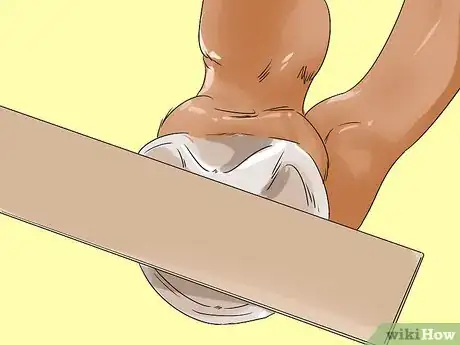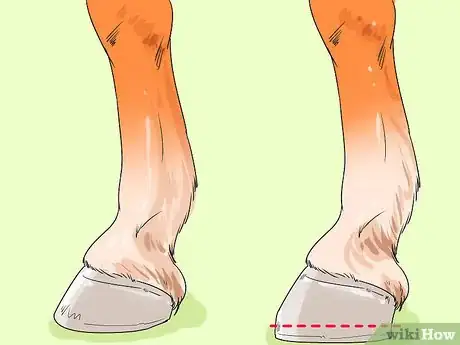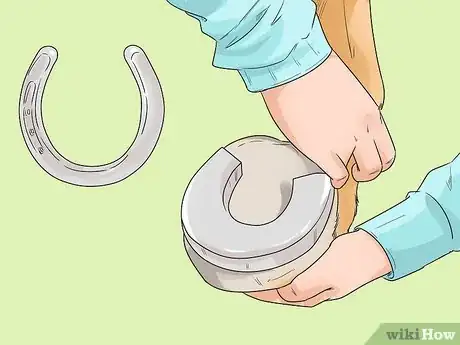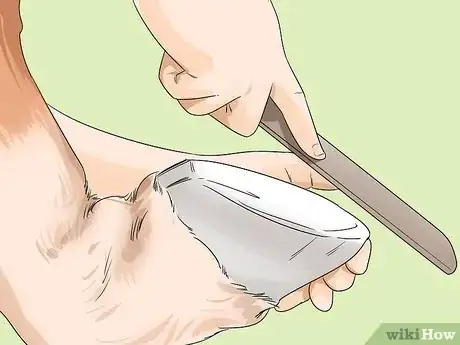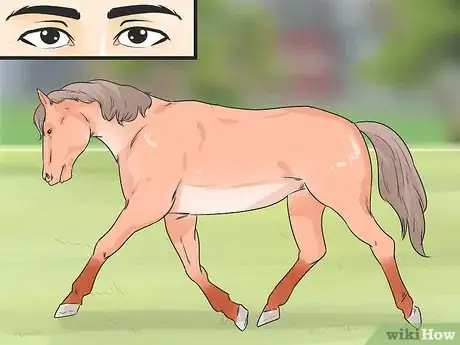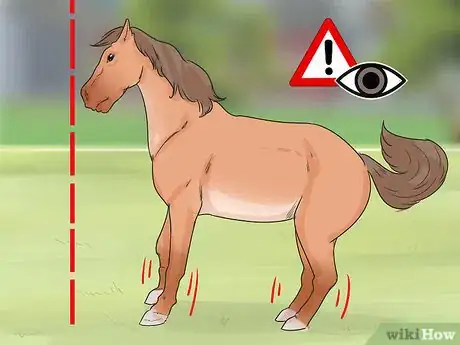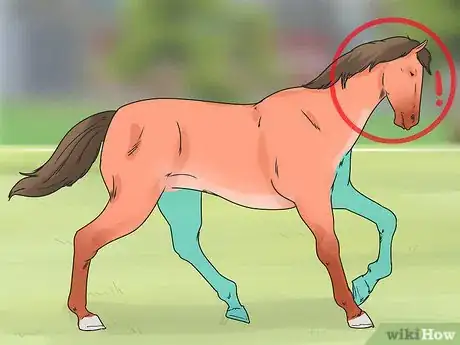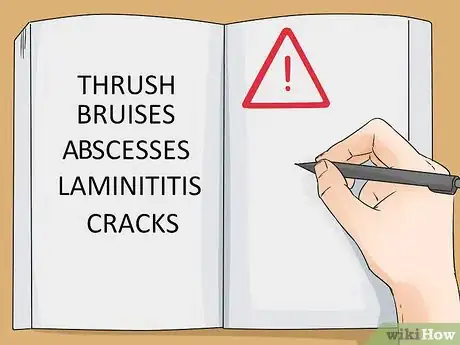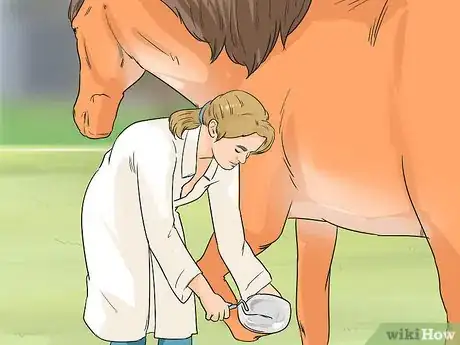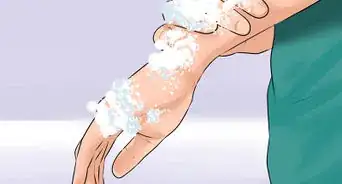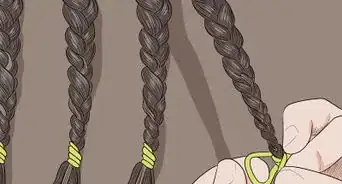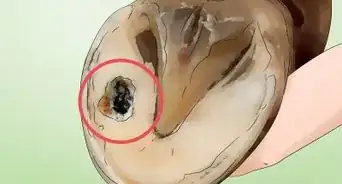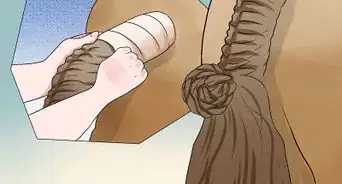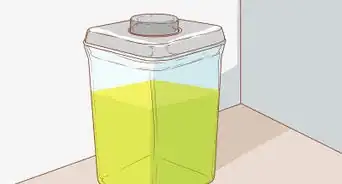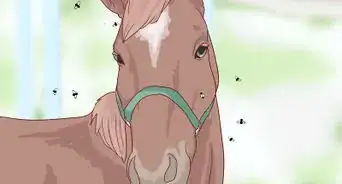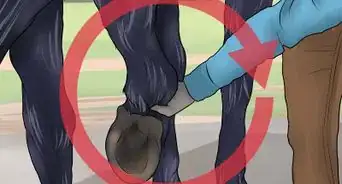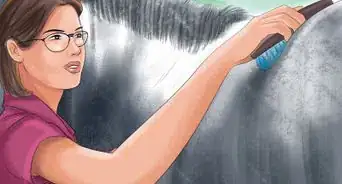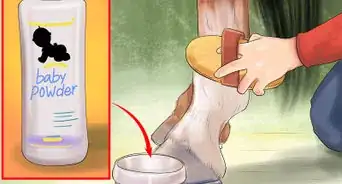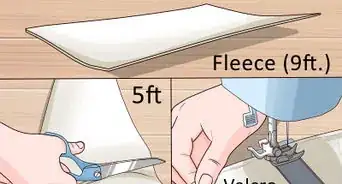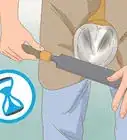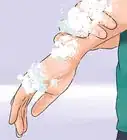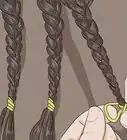This article was co-authored by Ryan Corrigan, LVT, VTS-EVN. Ryan Corrigan is a Licensed Veterinary Technician in California. She received her Bachelor of Science in Veterinary Technology from Purdue University in 2010. She is also a Member of the Academy of Equine Veterinary Nursing Technicians since 2011.
This article has been viewed 23,056 times.
Proper trimming of your horse's hooves is the key to keeping the animal healthy and mobile. Each hoof should be trimmed every 4-6 weeks depending on your horse, how its hooves grow, and how it wears down its hooves. A hoof that is trimmed improperly, however, may result in the horse having some soreness and discomfort. When this happens, work to identify and eliminate that soreness as soon as possible. Eliminating soreness requires inspecting for proper trimming, adjusting how much is trimmed, and protecting your horse's hooves from damage and disease.
Steps
Eliminating Soreness
-
1Hire a professional. If your horse seems to be suffering as a result of hoof trimming, first consult with your barn, your veterinarian, and local tack stores to find an experienced and professional farrier that is highly recommended to take care of your horse’s hooves. This is the safest, most responsible way to approach the situation.
-
2Get proper training on trimming. If you are interested in trimming your horse’s hooves yourself, undergo proper training from an experienced and highly trained farrier (professional horseshoe applier) or veterinarian. There are a lot of bones, tendons, ligaments, and soft tissue structures to take into consideration when trimming and adjusting your horse’s hooves.Advertisement
-
3Fix improper trimming. If your horse's hooves are trimmed improperly, it could be causing some discomfort. A horse's gait requires a delicate balance on the ground. If the horse's hooves are trimmed unevenly, it could throw off the horse’s gait and cause some discomfort.[1]
- For example, when trimming the bottom of a horse's hooves one must make sure that the bottoms are completely level to the ground. Any deviation from parallelism will put an awkward force up through the horse's legs when it takes a step.
-
4Let the hooves grow out. If your horse's hooves were cut down too far when they were trimmed, you will need to let them grow out. This is the only way that the sensitivity on the hooves will diminish. Go to a horse supply and accessory store and purchase booties with gel soles. Put the gel booties over the hooves to help the horse feel more comfortable walking while you wait for the hoof wall to grow down.
- Luckily, horses’ hooves grow pretty rapidly. Typically, you should have a horse’s hooves trimmed every four to six weeks. That means that within a few weeks, hooves that were trimmed too close should have grown out.[2]
-
5Put shoes or pads on the horse's hooves. One way to help a sore hoof is to put a horseshoe or a pad on it. The horseshoe will protect the horse's hoof from contact with items on the ground, such as rocks and sticks. The pad will reduce the impact that gets put on the hoof when your horse walks.[3]
- A horse that is having shoes put on will have their hooves trimmed differently than a horse that is going without shoes. With this in mind, consider hiring a farrier to trim and put shoes on a horse that is having soreness issues in its hooves.
- There are a wide variety of pads that are made for horses hooves. These are made from a variety of materials but are often plastic or leather. Pads protect the hoof while it is sore but are not a permanent solution for the horse's pain.
-
6Trim hooves less aggressively.[4] If your horse’s hooves are getting sore after being trimmed, then you should try to trim less of the hooves next time. Some horse's hooves are prone to soreness due to their structure, so they need to be trimmed more carefully and less aggressively.[5]
- If you have a farrier trim and shoe your horse, be sure to have a conversation with them about the pain your horse is experiencing and how that can be avoided next time the horse's hooves are trimmed.
Identifying Sore Hooves
-
1Watch how the horse moves. In order to identify a problem with your horse’s hooves, you should watch how your horse moves. A problem is usually easiest to identify when your horse is trotting, as opposed to walking. This is because a problem will not usually show up when a horse is walking unless it is really bad.[6]
- In order to figure out if something is off with your horse's gait, you should know what it looks like when it is correct. In addition, become familiar with how your horse's whole body moves when it walks and trots and how it sounds when the horses hooves hit solid ground. These things can help you identify when there is a problem.
- Be sure to ask a knowledgeable friend, farrier or veterinarian for help if you are unsure about whether your horse is sore or not. Don’t wait to see if the problem gets worse.
-
2Look for your horse’s hesitance to apply pressure to a hoof. Tenderness in a hoof will cause your horse to try to avoid using it. When you are watching your horse move, look for differences in the amount of pressure it’s placing on each hoof.[7]
- If a hoof is sore, your horse will change the distribution of its weight to keep pressure off of that hoof. This can change the horse's movement dramatically.
- Your horse may also cock and rest its hoof more frequently if it’s experiencing soreness.
-
3Pay attention to head movement at a trot. If your horse has a sore hoof it may bob its head while trotting. Normally, a horse doesn't need to move its head for balance when trotting because the symmetry of each hoof hitting the ground keeps it balanced.[8]
-
4Inspect the horses hooves for improper trimming. Look for problems in your horse's hooves if you suspect a sore hoof. Make sure that the hoof was trimmed properly and that there are no other problems causing the horse discomfort.
- When a hoof is properly trimmed the outside wall will be cut down and then leveled first. Then the inside sole will be trimmed down so that it’s lower than the outside wall.
- One reason the horse's hoof might be sore is if the inside sole is too high and the horse's weight is being placed on the sole and not the outside wall.
-
5
-
6Get a veterinary exam. If you cannot figure out why your horse is experiencing discomfort then you may need to get a professional opinion. A veterinarian will usually give your horse a general physical exam, will look at the horse's hooves, and look at its gait in order to identify the problem.
References
- ↑ http://extension.missouri.edu/p/G2839
- ↑ http://extension.missouri.edu/p/G2839
- ↑ http://www.thehorse.com/articles/10371/tending-to-a-tender-foot
- ↑ http://www.horsechannel.com/horse-experts/horse-vet-advice/2016/sore-hooves-after-a-trim.aspx
- ↑ http://www.thehorse.com/articles/10371/tending-to-a-tender-foot
- ↑ https://books.google.com/books?id=-uoaGHgT8H0C&lpg=PA139&ots=6AeLsh4NR9&dq=spotting%20sore%20hooves&pg=PA138#v=onepage&q=spotting%20sore%20hooves&f=false
- ↑ https://books.google.com/books?id=-uoaGHgT8H0C&lpg=PA139&ots=6AeLsh4NR9&dq=spotting%20sore%20hooves&pg=PA138#v=onepage&q=spotting%20sore%20hooves&f=false
- ↑ https://books.google.com/books?id=-uoaGHgT8H0C&lpg=PA139&ots=6AeLsh4NR9&dq=spotting%20sore%20hooves&pg=PA138#v=onepage&q=spotting%20sore%20hooves&f=false
- ↑ https://www.smartpakequine.com/content/common-horse-hoof-problems
About This Article
If your horse seems to be suffering from soreness after having its hooves trimmed, consult with your veterinarian to find a professional farrier who is qualified to care for your horse’s hooves. If you are trained to care for horse hooves yourself, check your horses hooves for improper trimming that might be causing an imbalanced gait and re-trim to make the hooves level. If the hooves have been trimmed to far down, buy some gel booties from a horse supply store to ease your horse’s soreness while you wait for the hooves to grow out again. Alternatively, put horse shoes or pads on your horse’s hooves to protect them from rocks and sticks. For more tips from our Veterinary co-author, like how to identify other possible causes of your horse’s discomfort, keep reading!
